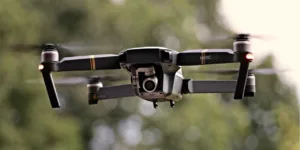Drone delivery is part of one of the biggest incoming trends in the technology industry, robotics. In this space, one organization (Google Wing) appears to stand alone with not only the most near term capable drone solution but active involvement in creating what will likely be an automated ground control infrastructure for drones. Hence, we avoid collisions and don’t have to worry about being hit by falling drones and package parts. We could see many shopping centers become delivery hubs to warehousing rapid delivery products and food production while still serving, once the Pandemic is finally under control, a local clientele.
Let’s talk Drone Delivery this week and what the future is likely to look like (and not long term future either, I’m talking around 2025 for many areas).
Creating A Viable Drone
I have a small drone airforce myself, but the problem with the vast majority of personal drones, which severely limit their range, is that they are continually fighting gravity with their lift engines. And, should they lose power, they become ballistic objects falling rapidly because they have nothing to slow their descent. Besides, they are relatively dense so that, though small, when they hit you, they can hurt a lot.
If you move up in size to a drone that is designed to carry packages, this density could make the drone deadly, but Google’s Wing’s solution is far more pedestrian-friendly. First, it has wings, which means that, once up to speed, the lifting engines can be dialed back or, depending on weight, shut off. This design advantage not only extends the range of the drone but provides a glide option should it lose power. Also, being Styrofoam, even if it falls ballistically, it will hit a relatively low terminal velocity (granted also depending on what it is carrying). This material choice reduces significantly the amount of damage it can cause if it fails catastrophically.
When it delivers a package, it will hover and then lower the package to the ground slowly until it releases the package and returns to base. While it will be louder during this procedure, that lack of having to land and take off should keep the noise down substantially, and when at cruise speed with most of the engines shut down, it should also be comparatively quiet.
In trials, the drones have taken over up to 25% of the delivery business for food delivery. One of the significant advantages is speed. Not traffic lights, insulated packaging, and direct flights assure the food arrives both quickly and still hot, which is often not the case with land-based services like Uber Eats.
Air Traffic Control
Google Wing is an aggressive supporter of the OpenSky. This solution is an app-based offering for both commercial and recreational fliers. Currently, it mostly showcases where drones can and cannot fly. Future versions will provide additional tools like remote identification, automated flight approvals, and strategic deconfliction (a complicated way of saying it should keep the things from colliding).
This capability is critical for success because, at expected capacity, there could be thousands of drones from different suppliers flying in the same air space at the same time, so keeping them from bombing pedestrians and cars would be a critical part of any solution. Wings have also provided an operations interface into their solution so that regulators can oversee airspace access to assure safety and compliance.
Collectively this massively reduces the risks associated with flying drone delivery.
Wrapping Up: Looking To The Future
The Google Wing drone has an operational range of 6 miles, which isn’t a lot when you are covering a city. But with existing shopping centers designed to be conveniently placed and likely in some trouble due to the Pandemic and related changing buying patterns may likely be converted to drone depots with restaurants. This last would be to provide drone delivery for the restaurants but also provide a breathtaking view of drones landing and taking off for those that want to eat locally. And with defined locations and resulting well-defined traffic routes as air taxis come online, it would provide a rapid way to safely implement that service for those wishing to eat and drink while avoiding the risks of a DUI or want to have a faster method to go out to eat. Oh, and coincidently, one of Google’s founders is also working on that.
If we survive this year, this decade will be really interesting for robotic flying vehicles.








